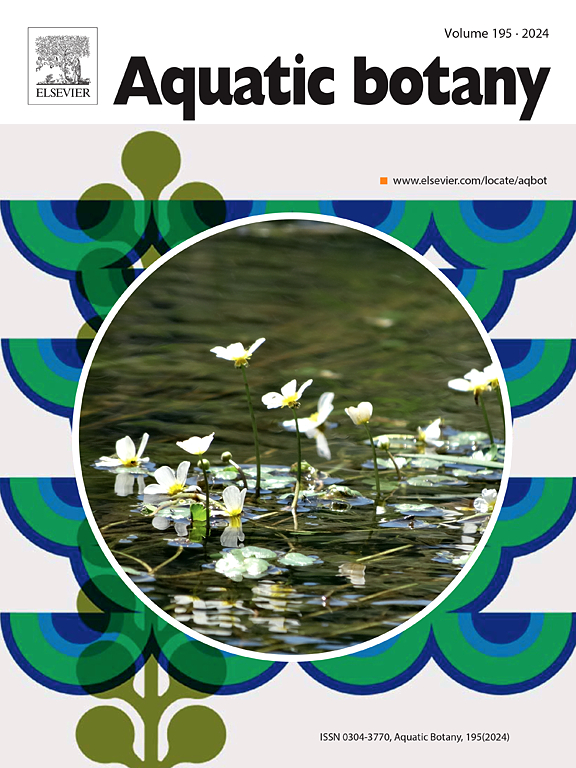Evaluating the combined methods of live planting and seed dispersal in restoration of Zostera marina (eelgrass) in Barnegat Bay, New Jersey by genetic diversity and pedigree analysis of restored populations
IF 2.6
4区 生物学
Q2 MARINE & FRESHWATER BIOLOGY
引用次数: 0
Abstract
Zostera marina (eelgrass) is a near-shore marine plant species that provides essential ecosystem services both as food and refuge for a variety of sea life, as well as a physical anchor for the littoral sediment along temperate coastlines. Due to disease, anthropogenic reductive effects, and recent natural disasters, Barnegat Bay, NJ has seen a reduction in natural populations of the species over the last few decades. Newly restored beds of Z. marina were planted in 2021 and 2022 by a combined method of live transplants and seed dispersal. In 2023, we acquired tissue samples from restored populations with the following objectives: A) test how successful the combined restoration method was at producing thriving populations, B) determine genetic diversity and “genetic health” as partial indicators of restoration success, and C) determine kinship in order to help correlate ancestry and efficacious seagrass growth progression. We found each restored population evinced increased genetic diversity over donor populations, based upon improved observed heterozygosity (mean 0.584), low inbreeding fixation levels (mean -0.146), and higher effective population sizes (mean 2.988). Principal Coordinate Analysis indicated that restored plants are primarily related to live planted donors, with alleles from seed donors in evidence. Cluster Analysis supports that restored individuals have genetic components of all donors, but also suggests environmental selection and genetic bottlenecking have occurred. Statistical analysis confirms the presence of bottlenecks in all restored populations. Overall, results support initial success in restored seagrass meadows. As global declines in seagrass beds continue, with the accompanying loss in genetic diversity, restoration techniques that demonstrate success in ecosystem service recovery and increased genetic diversity will guide practitioners in preservation and restoration of these habitats.
通过恢复种群的遗传多样性和系谱分析,评价新泽西Barnegat湾大叶藻(Zostera marina, eelgrass)恢复中活体种植和种子传播相结合的方法
大叶藻(Zostera marina)是一种近岸海洋植物,为各种海洋生物提供食物和避难所,同时也是温带海岸线沿岸沉积物的物理锚。由于疾病、人为减少效应和最近的自然灾害,在过去的几十年里,新泽西州巴内加特湾的自然种群数量减少了。采用活体移植和种子传播相结合的方法,于2021年和2022年种植了新修复的Z. marina床。2023年,我们从恢复种群中获取了组织样本,目的如下:A)测试联合恢复方法在产生繁荣种群方面的成功程度;B)确定遗传多样性和“遗传健康”作为恢复成功的部分指标;C)确定亲属关系,以帮助关联祖先和有效的海草生长进程。我们发现,由于观察到的杂合度提高(平均0.584),近交固定水平降低(平均-0.146),有效种群规模增大(平均2.988),每个恢复种群的遗传多样性都比供体种群有所增加。主坐标分析表明,恢复植株主要与活体供体有亲缘关系,来自供体的等位基因明显存在。聚类分析支持恢复个体具有所有供体的遗传成分,但也表明发生了环境选择和遗传瓶颈。统计分析证实,在所有恢复的种群中都存在瓶颈。总体而言,结果支持恢复海草草甸的初步成功。随着全球海草床持续减少,遗传多样性随之丧失,在生态系统服务恢复和遗传多样性增加方面取得成功的恢复技术将指导从业者保护和恢复这些栖息地。
本文章由计算机程序翻译,如有差异,请以英文原文为准。
求助全文
约1分钟内获得全文
求助全文
来源期刊

Aquatic Botany
生物-海洋与淡水生物学
CiteScore
3.80
自引率
5.60%
发文量
70
审稿时长
6 months
期刊介绍:
Aquatic Botany offers a platform for papers relevant to a broad international readership on fundamental and applied aspects of marine and freshwater macroscopic plants in a context of ecology or environmental biology. This includes molecular, biochemical and physiological aspects of macroscopic aquatic plants as well as the classification, structure, function, dynamics and ecological interactions in plant-dominated aquatic communities and ecosystems. It is an outlet for papers dealing with research on the consequences of disturbance and stressors (e.g. environmental fluctuations and climate change, pollution, grazing and pathogens), use and management of aquatic plants (plant production and decomposition, commercial harvest, plant control) and the conservation of aquatic plant communities (breeding, transplantation and restoration). Specialized publications on certain rare taxa or papers on aquatic macroscopic plants from under-represented regions in the world can also find their place, subject to editor evaluation. Studies on fungi or microalgae will remain outside the scope of Aquatic Botany.
 求助内容:
求助内容: 应助结果提醒方式:
应助结果提醒方式:


